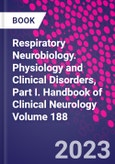Table of Contents
1. Respiratory rhythm and pattern generation: Brainstem cellular and circuit mechanisms2. Central respiratory chemoreception
3. Neurobiology of the carotid body
4. Adaptive cardiorespiratory changes to chronic continuous and intermittent hypoxia
5. Early development of the breathing network
6. Critical roles for breathing in the genesis and modulation of emotional states
7. Breathing during sleep
8. The physiology and pathophysiology of exercise hyperpnea
9. Regulation of breathing by cardiopulmonary afferents
10. Respiratory-cardiovascular interactions
11. Dyspnea
12. The pathophysiology of opioid-induced respiratory depression
13. The sigh and related behaviors
14. Neural control of the lower airways: Role in cough and�airway inflammatory disease
15. The phrenic neuromuscular system
16. Respiratory neuroplasticity: Mechanisms and translational implications of phrenic motor plasticity








